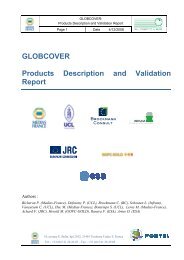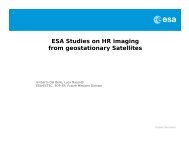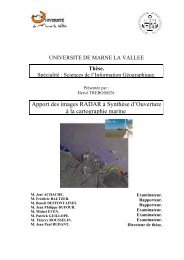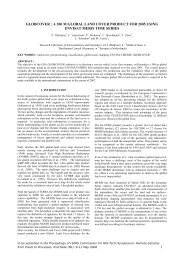Medspiration â System Requirements Document - Data User Element
Medspiration â System Requirements Document - Data User Element
Medspiration â System Requirements Document - Data User Element
Create successful ePaper yourself
Turn your PDF publications into a flip-book with our unique Google optimized e-Paper software.
<strong>Medspiration</strong><br />
MED-SOC-RS-001_1<br />
<strong>System</strong> <strong>Requirements</strong> <strong>Document</strong><br />
Issue F<br />
Figure 3-4. The Archive is at the core, receiving data input from CMS and providing the<br />
source of DDS data for SOC. The archive supplies data to the dissemination function.<br />
Periodically the L4 processor uses L2P data from the archive to generate L4 products<br />
which are entered into the archive. Periodically the match-up dataset processor<br />
operates, drawing L2P data from the archive and in situ data from the CORIOLIS facility<br />
at IFREMER to generate MDB records for GHRSST-PP.<br />
Archive<br />
The archive receives L2P data as soon as they are produced at CMS. It receives L4 data<br />
products generated at IFREMER by the L4 processor. It also receives ancillary datasets<br />
of wind speed fields and surface solar irradiance required for the diurnal variability<br />
module of the L4 processor. The archive may receive data that are too old to meet the<br />
operational timeliness requirements of GHRSST-PP. <strong>Data</strong> are registered when they<br />
enter the archive, MMR records are sent to GHRSST-PP, and the location and timing of<br />
each dataset is entered into a database to facilitate searching. The archive is partitioned<br />
between on-line and off-line storage, and daily back-ups are made.<br />
L4 UHR data production at IFREMER<br />
The L4 UHR data production is performed on a daily cycle. All the L2P and ancillary data<br />
acquired by sensors between 00:00 to 23:59 on day T, which is available in the archive at<br />
06:00 UTC on day T+1, is used to generate L4 product to be delivered by 11:59 on day<br />
T+1. The L4 processor has four modules as shown in Figure 3-6.<br />
The first identifies the measured SST data available for each location and selects<br />
according to quality criteria, defined in a configuration file. All the measured SST data<br />
correspond to skin or subskin observations.<br />
The second module estimates the diurnal variation (DV) of the difference between<br />
SSTskin and SSTfnd, or SSTsubskin and SSTfnd, making use of ancillary data contained<br />
within the L2P products, additional wind speed or SSI data if available, and any regional<br />
factors that are supplied in a configuration file. By this means every L2P SST<br />
measurement is converted to an estimate of SSTfnd.<br />
The third module applies an optimal interpolation (OI) process to all the selected data,<br />
now converted to estimates of SSTfnd, in order to produce an analysed, gridded field of<br />
SSTfnd. It also attaches error estimates to each pixel in the field. This forms the core of<br />
the L4 SST product.<br />
© 2004 SOC Page 23 of 193








